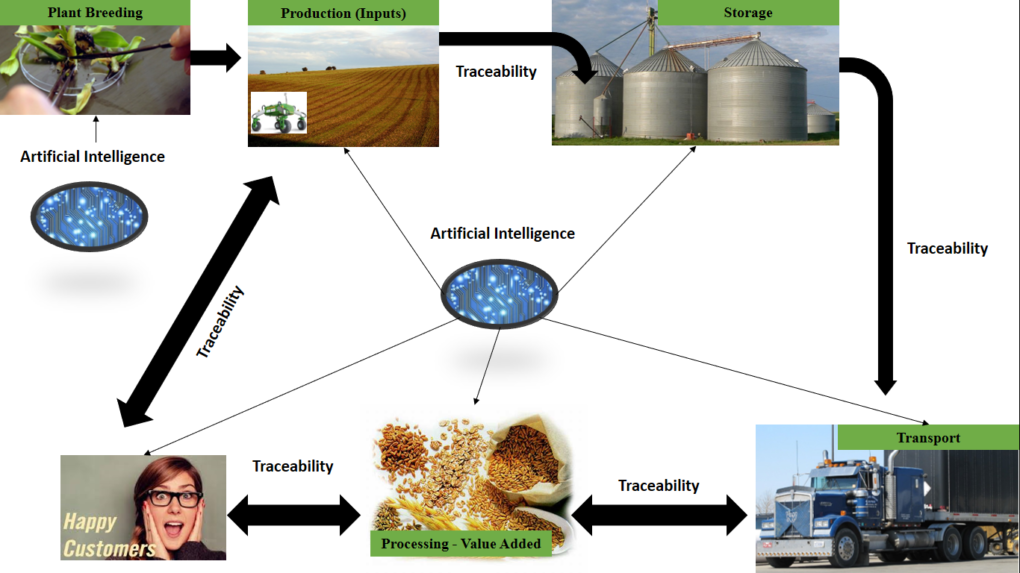From all over Canada experts convened in Saskatoon recently to discuss ‘Artificial Intelligence (AI) and Robotics in Agri-Food’ at the 2019 Agri-food Innovation Council (AIC) conference. Experts seem to disagree on whether AI is something new, or whether it’s just a fancy name for statistics. Given that AI draws on an ever-changing set of algorithms and approaches, and that AI techniques are used in many sub-disciplines (Figure 1), a universal definition for AI is very difficult to establish. Regardless of how it is understood, most experts at the 2019 AIC agreed that AI will eventually transform many (if not all) aspects of agriculture.

Source: Adapted from Shubhendu and Vijay (2013; p. 29)
AI in the Agricultural Sector
Future farmers that choose to adopt AI can expect most, if not all, activities to produce crops or rear livestock to be available as fully automated. Under full automation, the role of farmers, and the skills needed to farm will likely change as less human decision-making and labour will be needed to operate a farm. Whether one anticipates this or not, and whether one adopts these technologies or not, AI developers and large agriculture corporations are putting large amounts of resources into this precise effort. Figure 2 illustrates how AI could fully transform the value chain of a commodity.

What could AI Agriculture look like?
- It can be used to breed higher-yielding and more versatile crops by modelling complex data from the genomic and phenomic information of plants.
- Data from sensors mounted on automated equipment could be used in real-time to determine the optimal amounts of input (fertilizer, pesticides, etc.) needed to produce crops.
- Real-time readings could also be utilized to assess crop storage conditions (temperature, moisture, etc.) and be capable of recommending or making changes if needed.
- With the development of automated transports, we could eventually find our crops making their way to their destination markets on their own.
- Perhaps one of the more commonly discussed AI in agriculture is the use of ‘blockchain technology’ to provide information about the origin of the crop to anyone interested, and the conditions it has endured throughout its value chain (traceability).
Implications of Consumers
It’s expected that AI in agriculture will also have significant benefits for consumers. Pilot projects are currently offering consumers the ability to trace their food back to the farm from where it originated. Consumers can even obtain information about the chemical fertilizers/pesticides used to produce the food they purchase. However, knowing where and how the food was produced is not the only way in which AI will benefit consumers. In the health sector, AI will offer insights into personal healthcare. From designing custom diets to correcting calorie intake in case one cheats on one’s diet, AI will be used to create intelligent (capable of learning) personal nutrition assistants.
Can we expect only benefits from AI?
The notion of AI adoption might have you asking, is this fast-paced transition into a world dominated by AI necessarily a good thing? It’s often thought that AI will only affect ‘low-skilled’ jobs. However, a new study from Brookings questions this assumption (white-collar jobs will also be impacted). There are predominantly two camps in AI labour discussions: those who think AI will add jobs to the economy (optimistic) and those who think AI will substitute significant amounts of workers (pessimistic). Those who are optimistic often cannot provide figures as to how and wherein the economy, AI will add jobs. Moreover, important questions we need to consider as we continue our journey into a world of AI are:
- What does AI mean for hourly wages of workers in general? In an interconnected economy, adopting AI in one sector of the economy may have implications for workers in other sectors of the economy.
- What will the quality of jobs available be should AI substitute or create labour? Will these new jobs provide insurance benefits (pensions, dental benefits, vision care benefits etc.)?
- Can societies around the world restructure themselves as fast as AI is adopted into various sectors of the economy? If not, what will be the economic and social consequences of this lag in the restructuring process?
- Is AI a net benefit to the environment or a net environmental problem? Let’s not forget, robotics and computers require precious metals (a boom for the mining industry), and operating these, requires energy (fossil fuels still being the main source of energy on Earth).
Conclusion
AI is poised to provide tremendous benefits to agriculture and consumers. However, many issues around AI are still highly uncertain. So as not to be caught by surprise, experts and policymakers all over the world should give considerable thought to what a world in which AI is prominent looks like. Particularly, consumers in the near future will have vast amounts of data about the food they consume at their fingertips. How will consumers make sense of all this information? Who will the farmers of tomorrow be? Also, what will their role be? This blog is not meant to be a pessimistic view of AI, but rather to point out several questions and considerations we should be making going forward.


